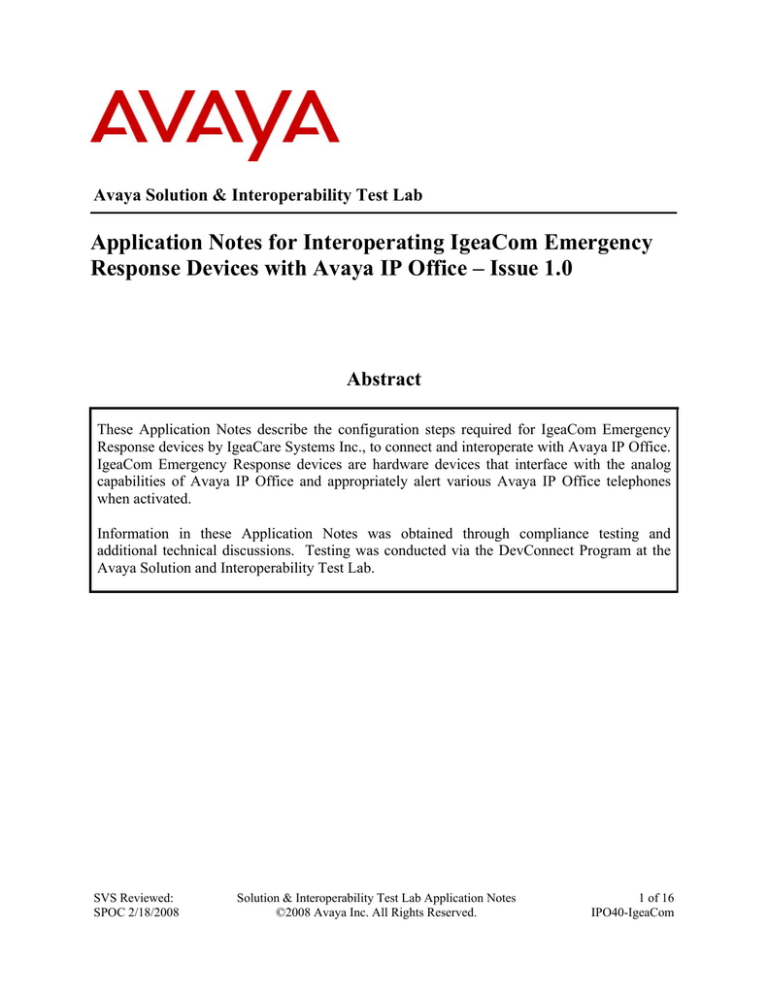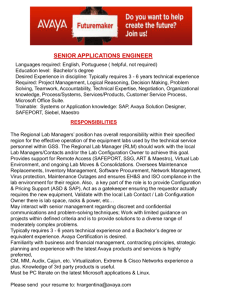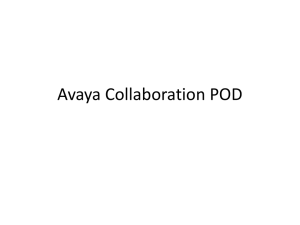
Avaya Solution & Interoperability Test Lab
Application Notes for Interoperating IgeaCom Emergency
Response Devices with Avaya IP Office – Issue 1.0
Abstract
These Application Notes describe the configuration steps required for IgeaCom Emergency
Response devices by IgeaCare Systems Inc., to connect and interoperate with Avaya IP Office.
IgeaCom Emergency Response devices are hardware devices that interface with the analog
capabilities of Avaya IP Office and appropriately alert various Avaya IP Office telephones
when activated.
Information in these Application Notes was obtained through compliance testing and
additional technical discussions. Testing was conducted via the DevConnect Program at the
Avaya Solution and Interoperability Test Lab.
SVS Reviewed:
SPOC 2/18/2008
Solution & Interoperability Test Lab Application Notes
©2008 Avaya Inc. All Rights Reserved.
1 of 16
IPO40-IgeaCom
1. Introduction
These Application Notes describe the compliance-tested configuration verifiying IgeaCare
Systems’ IgeaCom 500 and IgeaCom 700 devices (IgeaCom devices) interoperability with
Avaya IP Offices. The IgeaCom devices are wireless, push-button, and pull-cord devices that
integrates the traditional patient-to-nurse, nurse-to-staff functionality by providing instant twoway speech connectivity between the IgeaCom device and Avaya endpoint(s). The devices are
essentially an analog speaker telephone, primarily for nursing-home residents to communicate
with the staff. Avaya IP Office adds additional capabilities for alerting multiple destination
endpoints, whether located locally or remotely over a Small Community Network (SCN) trunk.
Avaya IP Office SCNs allow dial plan information to be shared between multiple Avaya IP
Offices. SCNs are also used to collectively ring extensions across two (or more) Avaya IP
Offices by dialing a single hunt group extension.
The IgeaCom devices are connected to the Avaya IP Office Analog telephone ports and are
configured within the IgeaCom application, to alert an individual telephone or a group of
telephones.
The configuration shown in Figure 1 below was used to compliance test the IgeaCom devices
with the Avaya IP Offices.
SVS Reviewed:
SPOC 2/18/2008
Solution & Interoperability Test Lab Application Notes
©2008 Avaya Inc. All Rights Reserved.
2 of 16
IPO40-IgeaCom
Figure 1 – Network Configuration Diagram
The test configuration simulates local and remote Avaya IP Offices communicating with each
other over a SCN trunk. This gives the IgeaCom devices the advantage of dialing a single
station, or a hunt group with a number of stations on either or both Avaya IP Offices, without
performing additional administration.
Note: For test purposes, pulling the wireless pull cord, or pushing the wireless pendant button
are referred to as IgeaCom button pressing.
SVS Reviewed:
SPOC 2/18/2008
Solution & Interoperability Test Lab Application Notes
©2008 Avaya Inc. All Rights Reserved.
3 of 16
IPO40-IgeaCom
2. Equipment and Software Validated
The following products and software were used for the configuration in Figure 1:
Product
Avaya IP412 Office
Avaya IP406 Office V2
Avaya IP400 Phone Module (Analog)
Avaya IP400 Digital Station Module
Avaya IP Office Manager
Avaya 4620SW IP Telephone
Avaya 5620SW IP Telephone
Avaya 2420 Digital Telephone
Avaya 5400 Digital Telephone
Avaya 3810 Digital Telephone Wireless
Avaya C363T – PWR Converged Stackable Switch
IgeaCare Systems Inc. IgeaCom 500
IgeaCare Systems Inc. IgeaCom 700
IgeaCare Systems Inc. Infra-Red Programming Link
IgeaCare Systems Inc. (for IgeaCom 500)
IgeaCare Systems Inc. – ACS (for IgeaCom 700)
PCs for Avaya IP Office Manager and IgeaCom
Programming Application
Software/Version
4.0.10
4.0.10
6.0.10
6.0.10
6.0.10
2.3
2.3
5.0
5.0
4.5.14
IC500-B1.4S 0807-0285
IC700-B1.0S 0806-0017
n/a
V6.11
V6.08.3
Windows 2003 XP
Professional Service Pack 2
Table 1 – Product and Software Version
3. Avaya IP Office
For all other configuration information, such as Avaya IP Office installation and configuration,
etc., please refer to the Avaya IP Office product documentation in reference [1].
3.1. Avaya IP412 Office Configuration
The configuration information provided in this section describes the steps required to set up
Avaya IP Office SCN, hunt groups, and user extensions on an Avaya IP412 Office. Except
where noted, similar configurations are performed on each Avaya IP Office.
1. From the IP Office Manager PC, go to Start → Programs → IP Office → Manager to
launch the Manager application. Log into the Manager application using the appropriate
credentials.
2. In the Manager window that is displayed, select File → Open to search for the IP Office
in the network.
3. Log into the Avaya IP412 Office using the appropriate login credentials to receive its
configuration.
SVS Reviewed:
SPOC 2/18/2008
Solution & Interoperability Test Lab Application Notes
©2008 Avaya Inc. All Rights Reserved.
4 of 16
IPO40-IgeaCom
4. In the Avaya IP Office Manager window, go to the configuration tree in the left-hand
panel and right-click Line and select New → IP Line (not shown). The screen below
should display.
In this case, the system automatically assigned 13 as the Line Number (this will vary).
Place the value 13 in the Incoming Group ID and Outgoing Group ID fields on the
VoIP Line tab. Click the VoIP Settings tab.
SVS Reviewed:
SPOC 2/18/2008
Solution & Interoperability Test Lab Application Notes
©2008 Avaya Inc. All Rights Reserved.
5 of 16
IPO40-IgeaCom
5. Set the Gateway IP Address to the IP address of the other Avaya IP Office (see Figure
1). Check the Voice Networking check-box. The Voice Networking parameter turns on
SCN capabilities. Click OK.
Note: The IP address will be different when administering the other Avaya IP Office.
SVS Reviewed:
SPOC 2/18/2008
Solution & Interoperability Test Lab Application Notes
©2008 Avaya Inc. All Rights Reserved.
6 of 16
IPO40-IgeaCom
6. In the Avaya IP Office Manager window, go to the Configuration Tree and double-click
User. In the User list displayed, scroll down and select the analog user assigned to the
IgeaCom device. In this case, extension 55233. Assign a Name to this user. In this case,
the Name is Room 101, which indicates when the button is pressed on the IgeaCom
device, the endpoint party responding will see Room 101 on the telephone display. Click
OK.
7. Repeat step 6 if additional IgeaCom devices are connected.
SVS Reviewed:
SPOC 2/18/2008
Solution & Interoperability Test Lab Application Notes
©2008 Avaya Inc. All Rights Reserved.
7 of 16
IPO40-IgeaCom
8. Check that the Advanced Small Community Networking license is installed by selecting
License on the left panel Configuration Tree. Note: A right-click on the middle panel
allows a license key to be entered.
Note: The compliance testing was performed over SCN trunks, where the dialplan and
hunt groups were shared. If this SCN network functionality is not required, this license is
not necessary.
SVS Reviewed:
SPOC 2/18/2008
Solution & Interoperability Test Lab Application Notes
©2008 Avaya Inc. All Rights Reserved.
8 of 16
IPO40-IgeaCom
9. Select HuntGroup (HG) on the left panel Configuration Tree. Create hunt group names,
numbers, and member extensions as described in the Table 2 below.
IgeaCom
Function
HG Name
HG Number
HuntGroup Member Extension(s)
and
IgeaCom Phone#
IgeaCom 500 device
CALL
Call500
Pendant
Pend500
Wireless Pull Bath500
Cord
Call Cord
Bed500
Menu
Menu500
Activities
Act500
55451
55454
55453
55262
55262, 55263
55262, 55263, 55304
55452
55455
55456
55262, 55263, 55304, 65210
55262, 55263, 55304, 65210, 65203
55262, 55263, 55304, 65210,
65203,65204
IgeaCom 700 device
Emergency
Emer700
55401
Pendant
Wireless Pull
Cord
Bed
Staff Assist
Code Blue
Pend700
Bath700
55404
55403
55262, 55263, 55304, 65210,
65203,65204
55262, 55263, 55304, 65210, 65203
55262, 55263, 55304, 65210
Bed700
Staff700
Code700
55402
55411
55409
55262, 55263, 55304
55262, 55263
55262
Table 2
Each IgeaCom device has been compliance tested using six different button push
functions. Each hunt group represents one of the six IgeaCom functions and the
associated extension number(s) notified when that function is activated. The alerting
extension(s) will see the analog extension Name (e.g. - Room 101) and the hunt group
Name (e.g. – Emer700) displayed on the telephone. Note: All hunt groups are set to
Collective Ring Mode.
SVS Reviewed:
SPOC 2/18/2008
Solution & Interoperability Test Lab Application Notes
©2008 Avaya Inc. All Rights Reserved.
9 of 16
IPO40-IgeaCom
Create a hunt group by right-clicking on HuntGroup from the left-hand panel
configuration tree and select New (not shown). On the right-hand panel, enter a Name
for the hunt group as per Table 2. In the Extension field, enter the extension assigned to
the hunt group as per Table 2. Click on the Add… button and select the members
extension from the extension list (not shown) as per Table 2. In this case, the name of
the hunt group is Bed700, the hunt group extension is 55402 and the member extensions
are 55262, 55263, and 55304. Click OK.
Note: Do not set up hunt groups on other Avaya IP Offices using SCN trunks.
10. In the Avaya IP Office Manager, select File → Save to push the configuration to the IP
Office and wait for the system to update. This completes configuration of Avaya IP
Office.
11. Repeat Steps 4 – 8 and 10 on the Avaya IP406 Office V2. This completes configuration
of Avaya IP Office.
4. Configure IgeaCom
Each IgeaCom device must be programmed to reflect the dial plan of the Avaya IP Offices. In
addition to the dialed number, the IgeaCom device provides many additional dialing parameters
as well as supporting visual display indicators. Please see IgeaCare Systems Inc. documentation
Reference [3] for more detail information regarding configuration capabilities.
SVS Reviewed:
SPOC 2/18/2008
Solution & Interoperability Test Lab Application Notes
©2008 Avaya Inc. All Rights Reserved.
10 of 16
IPO40-IgeaCom
4.1. IgeaCom Administration
The IgeaCom device programming tool software is installed by simply clicking on the setup.exe
file on the installation disk.
1. Once the software is loaded, the application is activated at Start → Programs →
IgeaCare Systems Inc. → IgeaCare Systems Inc. – ACS. The application screen
below should be displayed and is used to load the IgeaCom 700.
2. The above application must work in conjunction with a serial-port-connected Infra-Red
Programming Link tool. This Infra-red device is physically mounted on the IgeaCom
500 or IgeaCom 700 device, and is serially terminated on a PC COM port. The COM
port used above is COM1.
3. To place the IgeaCom device in infra-red download (programming) mode,
simultaneously press both Volume buttons for approximately 5 seconds or until three
single beeps are heard. The device will beep approximately every 5 seconds while in
SVS Reviewed:
SPOC 2/18/2008
Solution & Interoperability Test Lab Application Notes
©2008 Avaya Inc. All Rights Reserved.
11 of 16
IPO40-IgeaCom
download mode. Note: To end infra-red download mode, press both Volume buttons
until three single beeps are heard.
4. Configure the IgeaCom buttons as describe in Table 2. The numbers placed in the right
Phone # field below are the Hunt Group numbers that will be dialed by the IgeaCom
device when that function button is pressed. Each function button can further be tuned
with Delay, Redial, Silent, Light, and Priority. For additional information, see
IgeaCom reference [2] and [3].
• Phone #: Enter the phone or hunt group number that the IgeaCom device should dial
when the function button is pressed. The first Phone # is the primary contact and the
second Phone # field is the rollover contact (not populated above).
• Delay: Enter the amount of time that IgeaCom device should wait before dialing the
rollover phone number (in minutes).
• Redial: If the IgeaCom device should redial the primary and rollover number if no
answer.
SVS Reviewed:
SPOC 2/18/2008
Solution & Interoperability Test Lab Application Notes
©2008 Avaya Inc. All Rights Reserved.
12 of 16
IPO40-IgeaCom
• Silent: Enable (Y) or disable (N) hearing the IgeaCom device dialing the primary or
rollover number.
• Light: The IgeaCom device has an option to connect to dome light. This was not
Compliance tested.
• Priority: Click on this field to set the priority on a scale of 1 to 6. The number 1 is the
highest priority and the number 6 is the lowest priority.
5. Click on Store into Device to download the configuration parameters from the PC onto
the IgeaCom device. Wait for a completion indication.
• Click Read from Device to read the installed parameters back into the application.
• Click Verify to compare the stored parameters on the right of the screen with those
retrieved from the device on the left.
• The Store into Device, Read from Device, and Verify buttons are displayed below.
6. Install the IgeaCom 500 by activating Start → Programs →IgeaCare Systems Inc. →
IgeaCare Systems Inc.. Repeat the Steps 2 - 5 above for all the IgeaCom 500 devices
using Table 2 for telephone number information.
7. This completes the programming of the IgeaCom devices.
SVS Reviewed:
SPOC 2/18/2008
Solution & Interoperability Test Lab Application Notes
©2008 Avaya Inc. All Rights Reserved.
13 of 16
IPO40-IgeaCom
5. Interoperability Compliance Testing
Interoperability compliance testing evaluated the ability of IgeaCom devices to call various
endpoints on a stand alone Avaya IP Office or multiple Avaya IP Offices configured using SCN
trunks.
5.1. General Test Approach
The general test approach was to program the IgeaCom buttons when pushed to contact different
Avaya IP Office members and hunt groups. Based on the button selected on the IgeaCom
device, endpoints on either or both Avaya IP Offices were contacted displaying the IgeaCom
location (Room) and number on the telephone.
Serviceability was conducted by unplugging/plugging the IgeaCom device from the Avaya
POTS module port. In addition, resetting the Avaya IP Office as IgeaCom device buttons were
being pressed.
5.2. Test Results
All functions of IgeaCom button pushing passed compliance testing and all test cases completed
successfully.
• There were no issues with programming the IgeaCom devices
• There were no communications difficulties within the network.
• There were no performance or load tests performed.
• Serviceability compliance tests passed.
6. Verification Steps
The following steps may be used to verify the configuration:
• Verify that each button on the IgeaCom device contacts an endpoint or each member in a
hunt group.
• Verify the display information is correct on the ringing endpoint.
• Verify two-way communication after endpoint answers call from IgeaCom device and
that it terminates correctly.
• Verify serviceability of IgeaCom device by unplugging during button push, then
reconnecting device without problems along with resetting Avaya IP Offices.
7. Support
Technical support for IgeaCare Systems Inc. can be obtained by contacting IgeaCare Systems Inc
at:
• Phone: (905) 707-1669 or 1-866-361-6225
• E-mail: support@igeacare.com
• Web: http://www.igeacare.com
SVS Reviewed:
SPOC 2/18/2008
Solution & Interoperability Test Lab Application Notes
©2008 Avaya Inc. All Rights Reserved.
14 of 16
IPO40-IgeaCom
8. Conclusion
These Application Notes describe the steps for configuring the IgeaCare Systems Inc. IgeaCom
devices with Avaya IP Offices.
Although not tested in compliance, the procedures in this document can be used for IgeaCom
300, 301, 501, MP501, 600, and 601 devices. The functionality may vary slightly between
devices but the administration is identical.
9. References
The following Avaya product documentation can be found at http://support.avaya.com:
[1] Avaya IP Office 4.0 Installation Manual, Issue 15e (31st January 2007), 15-601042.
The following IgeaCom product documentation was used and referenced during the compliance
test ( http://igeacare.com/downloads1.htm ):
[2] IgeaCom Acute Care User GuideV1.0, Part Number 9001001ACS.
[3] IgeaCom User GuideV8.0, Part Number 9001001.
[4] IgeaCom Software User Guide, V2.0 Part Number9001002.
SVS Reviewed:
SPOC 2/18/2008
Solution & Interoperability Test Lab Application Notes
©2008 Avaya Inc. All Rights Reserved.
15 of 16
IPO40-IgeaCom
©2008 Avaya Inc. All Rights Reserved.
Avaya and the Avaya Logo are trademarks of Avaya Inc. All trademarks identified by ® and ™
are registered trademarks or trademarks, respectively, of Avaya Inc. All other trademarks are the
property of their respective owners. The information provided in these Application Notes is
subject to change without notice. The configurations, technical data, and recommendations
provided in these Application Notes are believed to be accurate and dependable, but are
presented without express or implied warranty. Users are responsible for their application of any
products specified in these Application Notes.
Please e-mail any questions or comments pertaining to these Application Notes along with the
full title name and filename, located in the lower right corner, directly to the Avaya DevConnect
Program at devconnect@avaya.com.
SVS Reviewed:
SPOC 2/18/2008
Solution & Interoperability Test Lab Application Notes
©2008 Avaya Inc. All Rights Reserved.
16 of 16
IPO40-IgeaCom



